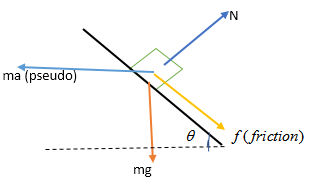Question
Question: If the coefficient of friction between A and B is \(\mu \). The maximum horizontal acceleration of t...
If the coefficient of friction between A and B is μ. The maximum horizontal acceleration of the wedge A for which B will remain at rest w.r.t the wedge is

A. μg
B. g(1−μ1+μ)
C. μg
D. g(1+μ1−μ)
Solution
Try to solve by taking A as a frame of reference and use pseudo force concept it will be easy that way you can also solve by taking ground as a frame of reference but then you will have to apply constraint equations which will make it little complex.
Complete step by step answer:
We will solve this question by taking wedge A as a frame of reference.
So free body diagram according as we observe B from A will be

balancing force perpendicular to incline we have,
N=mgcosθ+masinθso
Friction f=μN=μ(mgcosθ+masinθ)
And balancing force along the incline we have,
f+mgsinθ=macosθ
⇒μ(mgcosθ+masinθ)+mgsinθ=macosθ
⇒a=acosθ−μasinθgsinθ+μgcosθ putting θ=45∘we have
∴a=g(1−μ1+μ)
So, the correct answer is “Option B”.
Note:
In these types of questions, choosing a frame of reference is critical because choosing a better frame of reference makes a lot of things easy here. For example, once we take wedge A as a frame of reference we won’t have to worry about constraint equations and it makes it easier to solve such questions.
